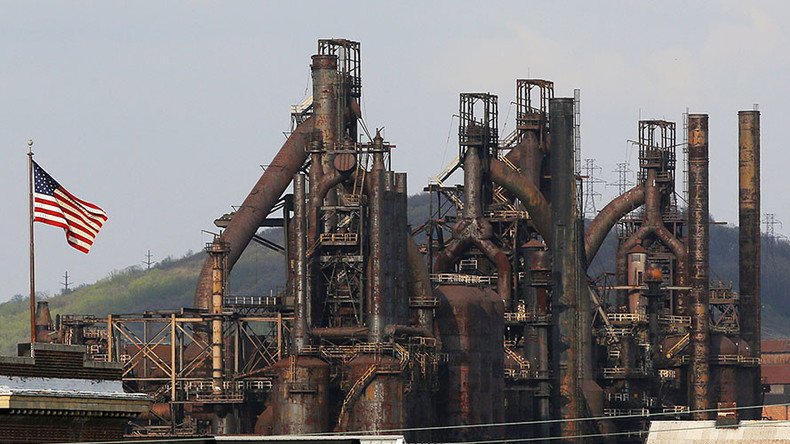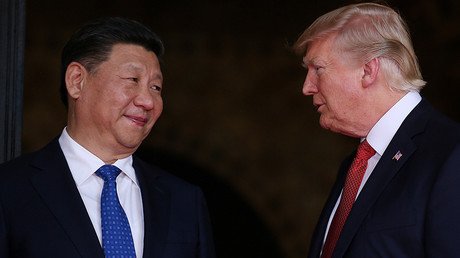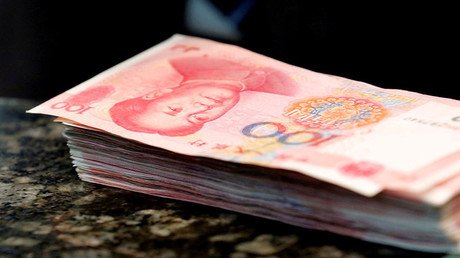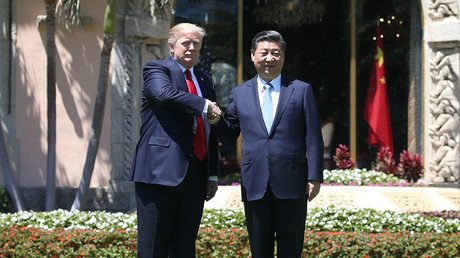Nervous of steel: Trump prioritizes foreign imports probe targeting China

President Donald Trump insists his move to accelerate an investigation into foreign-produced steel imported to the US has “nothing to do with China,” but Commerce Secretary Wilbur Ross cast China’s influence on the US market as possibly requiring tariffs.
An ongoing probe by the Commerce Department into cheap steel imports is now a priority for the Trump administration, following the signing of a presidential memorandum on Thursday.
President Trump made use of the seldom seen Section 232 of the Trade Expansion Act of 1962, which authorizes the president to cite national security reasons for ordering restrictions on imported goods. In his instructions, he left Commerce 270 days to complete a probe into whether imported steel threatens national security.
“Steel is critical to both our economy and our military. This is not an area where we can afford to become dependent on foreign countries,” Trump said, surrounded by US steel executives, Reuters reported.
Commerce Secretary Wilbur Ross, a former steel executive, told reporters the inquiry would likely be wrapped up much sooner than its early 2018 deadline. Whether it goes quickly or not, however, US-China relations stand to be impacted as a “new strategy” to deal with North Korea is carried out.
Ross explained the probe was a response to Chinese imported steel rising to 26 percent of the US market, “despite repeated Chinese claims that they were going to reduce their steel capacity,” Reuters reported. Steel shipped directly from China makes up just 2 percent of American steel imports, but other countries that process Chinese steel also export it to the US, the New York Times reported.
Any national security implications are unclear, as the Department of Defense has long required its procured steel be made in the US. In 2009, a rule change allowed imported steel to be purchased, but it had to be finished or treated in the US. In 2013, that rule was reversed, so that once again, the military acquired only steel produced, from beginning to end, within the US.
Reuters reports that the Pentagon’s annual steel needs make up less than 0.3 percent of the industry’s output by weight. US Navy shipbuilders Lockheed Martin Corp. and Huntington Ingalls Industries are reportedly the military’s largest consumers of steel.
In October 2001, a similar Commerce investigation determined there to be “no probative evidence” that imported iron ore and unfinished steel put national security at risk, according to Reuters.
China may wish to avoid a trade war with the US, but cutting back on steel production could prove to be quite costly itself. Chinese steelworkers represent 0.6 percent of that country’s labor force, or 4.7 million workers, based on 2014 figures, the New York Times reported. For comparison, US steelworkers comprise less than 0.02 percent of the US population, according to the US Bureau of Labor Statistics.
Stocks for US steelmakers shot up following the presidential memo signing. US Steel Corp. stocks rose 8 percent, while AK Steel, Cliffs Natural Resources, and Steel Dynamics were up more than 2.5 percent each, CNBC reported.
Steel stock prices have been erratic recently, as the Trump administration’s much-touted massive federal spending on infrastructure has run up against political reality, as healthcare and tax reform remain higher priorities, despite a slow pace in Congress. CNBC reports that earlier this month, US Steel stocks had their worst day since June 2016, dipping more than 9 percent.
China was targeted in a US Steel statement welcoming Trump’s memo signing Thursday.
“For too long, China and other nations have been conducting economic warfare against the American steel industry by subsidizing their steel industries, distorting global markets, and dumping excess steel into the United States. The effects have been staggering,” the statement said.
The White House echoed those concerns.
“The artificially low prices caused by excess capacity and unfairly traded imports suppress profits in the American steel industry, which discourages long-term investment in the industry and hinders efforts by American steel producers to research and develop new and better grades of steel,” the presidential memorandum reads.
China produced over 808 million metric tons of crude steel in 2016, far ahead of the next closest, Japan, which produced nearly 105 million metric tons, according to the “Monthly crude steel production 2016”report from the World Steel Association. The data shows the European Union produced about 162 million metric tons, while the US produced 78.6 million metric tons.
China produced 72 million tons last month alone, a new record, according to Reuters.
Section 232 of the Trade Expansion Act has only been acted on twice before, by presidents Richard Nixon and Gerald Ford, who cited national security risks amid the 1970s energy and oil crisis, Bloomberg reported.















